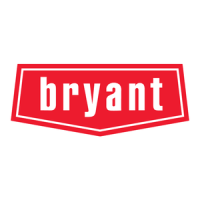
Do you have a question about the Bryant 589A and is the answer not in the manual?
| Brand | Bryant |
|---|---|
| Model | 589A |
| Category | Air Conditioner |
| Language | English |
General safety precautions for installation and servicing.
Identify and inspect unit for shipping damage and missing parts.
Install roof curb or concrete pad for proper unit support.
Secure field-fabricated ductwork to building structure and unit flanges.
Ensure required operating and service clearances for combustion and ventilation.
Use proper rigging and lifting techniques to place the unit level.
Observe safety warnings and perform inspections for shipping damage, leaks, and connections.
Locate and repair refrigerant leaks, then charge the unit.
Check heating control operation, burner ignition, and gas input.
Check cooling control operation, compressor, and fan startup.
Inspect and clean/replace air filters monthly for optimal performance.
Procedures for safely removing and reinstalling the unit top.
Clean and lubricate blower motor and wheel annually.
Inspect and clean flue collector box and heat exchanger areas.
Clean blower wheel periodically for proper airflow and heating efficiency.
Locate limit switch on gas partition for service.
Unit has direct spark ignition with a 100% lockout system.
Inspect main burner flames and adjust if necessary each heating season.
Inspect and clean coils and drain pan annually for proper operation.
Keep condenser fan free from obstructions for proper cooling operation.
Inspect electrical controls and wiring annually for tightness and operation.
Inspect tubing connections for oil accumulation annually.
Check gas input only if improper heating performance is suspected.
Check airflow if improper performance is suspected; ensure grilles are open.
Fixed orifice metering device located in evaporator coil header.
Wire mesh strainer protects metering device in liquid line.
Troubleshooting common cooling system problems and their remedies.
Diagnose and fix issues preventing compressor and fan startup.
Troubleshoot issues when compressor fails to start but fan operates.
Address noise and pressure issues with three-phase scroll compressors.
Troubleshoot short cycling or improper compressor operation.
Diagnose and resolve continuous compressor operation.
Identify causes and remedies for high head pressure.
Troubleshoot and resolve low head pressure issues.
Address and fix issues causing high suction pressure.
Diagnose and resolve problems with low suction pressure.
Troubleshoot common heating system problems and their remedies.
Diagnose and fix issues preventing burner ignition.
Address causes of inadequate heating performance.
Identify and resolve issues causing poor flame quality.
Troubleshoot hardware failures indicated by a blank LED.
Diagnose limit switch faults indicated by 2 LED flashes.
Troubleshoot flame sense faults indicated by 3 LED flashes.
Address 4 consecutive limit switch faults indicated by LED.
Troubleshoot ignition lockout indicated by 5 LED flashes.
Diagnose induced-draft motor faults indicated by 6 LED flashes.
Troubleshoot rollout switch faults indicated by 7 LED flashes.
Diagnose internal control faults indicated by 8 LED flashes.
Information on training programs for equipment knowledge.
Details on hands-on training for faster troubleshooting.
Verify pre-start-up items are completed before unit operation.
Record electrical, temperature, and pressure readings during startup.
